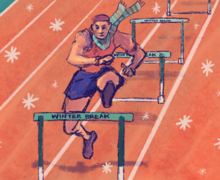3 takeaways from Syracuse’s overtime loss to Wake Forest
Corey Henry | Senior Staff Photographer
Despite Garrett Shrader and Sean Tucker outrushing Wake Forest, Syracuse fell in overtime to the Demon Deacons 40-37.
Get the latest Syracuse news delivered right to your inbox.
Subscribe to our sports newsletter here.
After the last two games for Syracuse ended in last-second field goals — one resulting in a win and the latter in a loss — the Orange couldn’t end their matchup against No. 19 Wake Forest in regulation.
But like its loss to Florida State, Syracuse was on the wrong side of the evening, falling 40-37 to undefeated Wake Forest. The Orange were blown out in last year’s contest against the Demon Deacons, losing 38-14 on the road. But SU kept this year’s matchup close, scoring 21 points in the first half, the most the Orange have scored against a Football Bowl Subdivision team this season.
Garrett Shrader passed for 160 yards and rushed for 178 in his third start with the Orange. He was aided in the rushing attack by Sean Tucker, who finished with 153 yards on 26 carries. Defensively, Syracuse held the Demon Deacons to less than their season average, but it wasn’t enough to win.
Here are three takeaways from SU’s first Atlantic Coast Conference home game:
Defensive up-and-downs
Wake Forest entered the game averaging 38.4 points per game, ranking 15th in the nation with scoring. The Demon Deacons’ quarterback Sam Hartman had 13 touchdowns heading into the game, with the fifth-best quarterback efficiency in the ACC.
The Demon Deacons’ offense is somewhat similar to Syracuse’s, allowing Hartman to make read options on most plays and keep the ball when he wants. Early on, Syracuse took away running lanes from Hartman and running back Christian Beal-Smith, holding the usually high-powered Wake Forest offense to three first-quarter points.
But Wake Forest started to move more toward the passing game, cutting Syracuse’s halftime lead to four points. The Demon Deacons established passes through the use of a sort of slow read option, pulling Syracuse’s linebackers up to the line and opening up the middle of the field.
In the second quarter, free safety Jason Simmons got burned in the center of the field, allowing a 46-yard touchdown from A.T. Perry. But Simmons made up for his previous mistake, picking off Hartman as the ball bounced off of Eric Coley’s shoulder pads.
The Demon Deacons continued to pass at the start of the second half, targeting the right sideline on two consecutive plays. Hartman completed both passes as Duce Chestnut and Garrett Williams were beat on out routes. In the red zone, however, Syracuse pressured Hartman, sending Cody Roscoe and Geoff Cantin-Arku from both edges of the line. Roscoe got to the quarterback first, setting up a 40-yard field goal that Nick Sciba hit.
On the next drive Hartman went at Williams again, finding Perry open in the middle of the field while Williams was facing the wrong way. After Perry caught the ball, Williams caught up, but Perry juked the cornerback before walking into the end zone for a 69-yard score.
After Andre Szmyt’s miss from 45 yards midway through the fourth quarter, Wake Forest relied on the pass again. On the first two plays of the drive, Hartman went deep to Jaquarii Roberson, finding him for 19- and 11-yard receptions. But 10 yards away from the end zone, the Demon Deacons relied on the run, creating a hole for Beal-Smith to score. They found the end zone again on the two-point conversion, taking a 34-27 lead.
In overtime, Hartman dropped back, looking towards the sidelines again for an open player. Perry, who had Chestnut on him, separated from the cornerback at the left side of the end zone, tilting his body and nudging the ball onto his side. The play was reviewed, and it stood as Hartman blew kisses to the Carrier Dome crowd.
Fewer linemen, no problem
As Syracuse’s players ran through the smoky tunnel before the start of the game, Chris Bleich and Darius Tisdale walked toward the sidelines. Tisdale, aided by a scooter, had a boot on his right leg, while Bleich was out for an unknown reason. But without Bleich at left guard, freshman Kalan Ellis made his first start for the Orange.
“He’s a massive human being, so to see him move out there is really impressive,” center Airon Servais said of Ellis. “He’s still working through things (because) he’s a freshman, but I thought he’s done a really good job of picking up the offense.”
After the first drive, however, Servais as the newly-appointed starting center limped to the sidelines. After seeing the athletic trainers, Servais only returned briefly at the end of the second quarter, replaced by Josh Ilaoa.
On Syracuse’s fourth drive, the offense started to mesh together completely, getting quick gains in the passing and rushing attack. With a third-and-1 at Wake Forest’s 5-yard line, the offensive line paved a perfect path for Shrader to run through, giving Syracuse a 21-10 lead.
Syracuse still started the second half off slow, allowing Wake Forest’s defense to force its second three-and-out of the game. But Elmore started coming up to the offensive line more, adding an extra blocker against some of the six-man fronts that Wake Forest was sending.
On third-and-5 with five minutes left in the third quarter, the offensive line created enough time for Shrader to stay in the pocket. But he decided to run as no receivers were open, ultimately unable to move the chains.
At the end of the game, Syracuse’s offensive line got back to its strength in the rushing attack, clearing up a hole for Tucker to get a first down. But Tucker was replaced with Cooper Lutz on the next play, and the ball popped out of his arms, landing in the hands of Wake Forest’s Ja’Sir Taylor.
The Orange only got the ball back once more before the end of the game, and Syracuse’s line started to bend. Still, Shrader made up for it, using his legs on multiple plays to bring Syracuse into Wake Forest territory. The line gave Shrader enough time to pass to Tucker a few plays later, sending the game to overtime.
With a third-and-long on Syracuse’s first drive in overtime, the line collapsed. Shrader dropped back, looking left and right for receiving options, but no one was available. He was brought down 5 yards behind the line of scrimmage, sending out Szmyt to give the Orange a three-point lead.
Replacing Taj Harris
Last Sunday, receiver Taj Harris announced he was leaving Syracuse for the transfer portal. Head coach Dino Babers said that he and Harris had conversations before and after the FSU game, and Harris decided the “best opportunity for him was to go into the transfer portal.”
Harris didn’t travel with the team to Tallahassee, Florida, allowing Babers to start finding players to replace the main receiving load. Anthony Queeley emerged from the bunch with the only receiving touchdown for the Orange, which was one of only two receptions he had in their loss to FSU.
Early against Wake Forest, Queeley got open in the play action, just as he did against Florida State last week. After Shrader faked a hand off to Tucker, Queeley separated from his defender on a corner route, breaking to the corner of the end zone wide open. Shrader found him to extend Syracuse’s lead to 14-3.
Courtney Jackson also took over the duties in the jet sweep, and the setup turned into a read option with Shrader, a strategy the Orange haven’t implemented this year. Early in the first quarter, Shrader kept the ball for a first down run, and in the second quarter, Jackson took the ball for crucial yardage.
In the second half, Syracuse continued to use the read option with Jackson on jet sweeps. Still, Shrader continued to air it out whenever he could in the passing game, finding Jackson open on the left sideline at the end of the third quarter. Jackson’s catch set up Tucker for his second rushing touchdown — and a 27-26 lead — on the ensuing play.
On Syracuse’s last drive of the game, Shrader looked for his receiving options on the first three plays, having to scramble on his feet to first down on the second. All his pass attempts went incomplete, as no receivers found separation from their defenders.
But on the final play of the drive, a non-receiver made a reception for the score. Tucker positioned himself alone in the middle of the field, catching the ball at the 20-yard line. The rest of Wake Forest’s defense was already in the end zone, and Tucker had a free path into the end zone to help the Orange tie the game, sending it to overtime.
Published on October 9, 2021 at 7:41 pm
Contact Anish: asvasude@syr.edu | @anish_vasu






